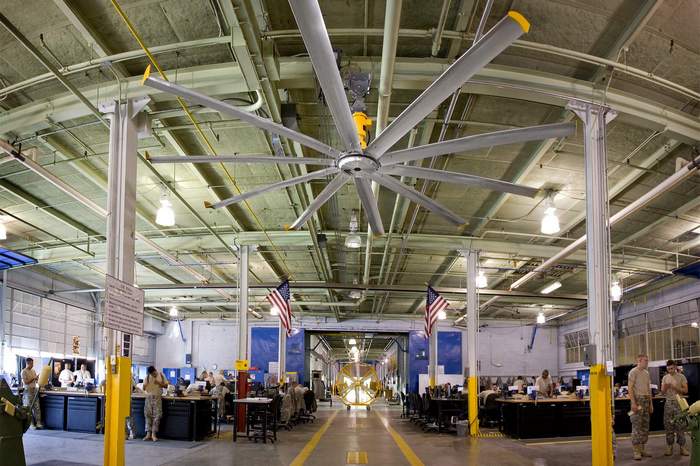
(Or, we just wanted to use the word “Big Ass” in a serious business article.)
While we’ve seen the topic of staff retention in warehouses and manufacturing plants come up more frequently than ever, most of the discussion until now has been focused on compensation and skill training. While there are legitimate needs to address stagnant pay, lack of career paths and insufficient training, in many cases retention is much more about creating a great work environment.
Summertime, And the Work Is Not Easy
With another record-breaking year for high temperatures (as of this writing, we are on pace for the fourth-hottest year on record), the physical nature of many positions in the distribution center means even higher fatigue rates, absenteeism and declines in morale. And while climate change tends to keep rising temperatures in the news more often, we must not forget a similar set of challenges exist in extreme cold and even damp conditions.
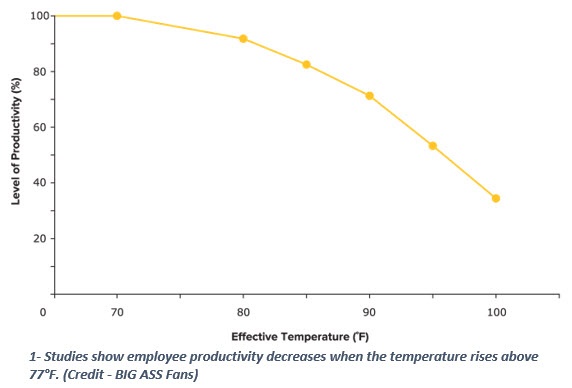
Let’s Clear the Air About Air Quality
Perhaps the simplest, most cost-effective way you could improve your work environment in regard to temperature – hot or cold – and even excessive moisture, is by moving it around more frequently. There is nothing attractive about working in a box-shaped building with a metal roof and no air conditioning in the middle of a hot summer. And if you have people working above the floor, be it in aisle pickers or cranes, or on a mezzanine level, they will take the brunt of what can be as much as a twenty-degree difference in temperatures between floor and ceiling.
Big Ass Fans out of Lexington, Kentucky, has a variety of solutions that improve your work environment just by circulating the air better. The Powerfoil 3.0 (pictured below), is one of many varieties of ceiling fans specially designed to circulate air from floor to ceiling and wall-to-wall, even around obstacles and stacked shelving.
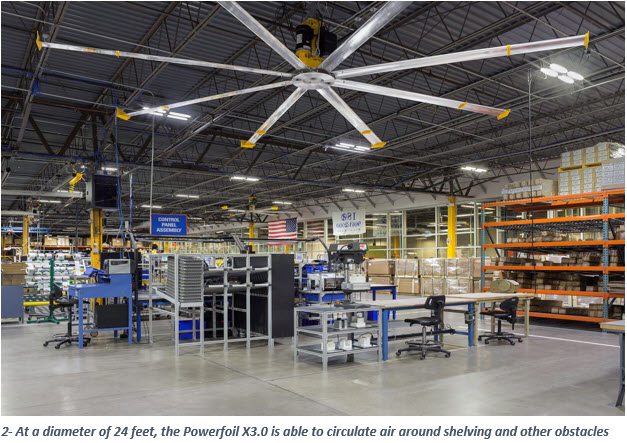
According to the Big Ass Fan website, correcting the airflow with a high-volume ceiling fan can make people feel up to 10°F (5.6°C) cooler in hot weather, and can cool a space and the people in it without the loud noises or snaking cords of individual and pedestal fans (they are apparently quiet enough to be used in some churches too). In colder weather, slowing the fans when heating the warehouse helps recirculate heat trapped near the ceiling back down to the floor, boosting workers’ comfort while reducing heating costs up to 30 percent.
Of course, there are many other smaller fans and heaters that can be deployed to fit your environment or the workflow to best accommodate your people, but these ceiling fans are a clever innovation that makes for a more comprehensive solution for your workspace.
Seeing is Believing
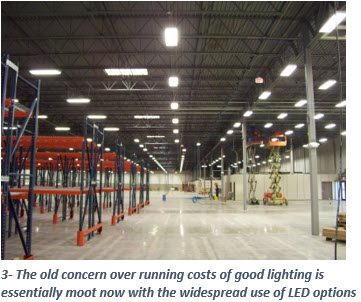 Another area often overlooked as a “comfort” factor for DC workers is lighting. Even for facilities where much of the space is full of bulk dry goods or pallets where the need to spot and read individual labels or barcodes is not necessary still require good lighting to help reduce worker fatigue. And this is not just a preference, but a rule as designated by OSHA. Facilities which have generated complaints about poor light levels have been hit with heavy fines. For example, reserve storage areas that are accessed only by lift, crane or aisle pickers may only require brightness of more than two lumens per square foot, but in that case the vehicles accessing those space are required to have “auxiliary directional lighting”. This is not just about following regulations, but more about your workers getting prematurely fatigued from poor visibility and the potential for costly mistakes and accidents it might create, or just the loss of another valuable worker (in this case a driver with qualification to operate your powered trucks!).
Another area often overlooked as a “comfort” factor for DC workers is lighting. Even for facilities where much of the space is full of bulk dry goods or pallets where the need to spot and read individual labels or barcodes is not necessary still require good lighting to help reduce worker fatigue. And this is not just a preference, but a rule as designated by OSHA. Facilities which have generated complaints about poor light levels have been hit with heavy fines. For example, reserve storage areas that are accessed only by lift, crane or aisle pickers may only require brightness of more than two lumens per square foot, but in that case the vehicles accessing those space are required to have “auxiliary directional lighting”. This is not just about following regulations, but more about your workers getting prematurely fatigued from poor visibility and the potential for costly mistakes and accidents it might create, or just the loss of another valuable worker (in this case a driver with qualification to operate your powered trucks!).
Ergonomic Options Abound
Finally, there are SO many other ways to improve comfort in your environment that not only do not hurt productivity but IMPROVE it. While some might entail overhauling an entire process area to accommodate the new equipment, others fit right into how you already do things.
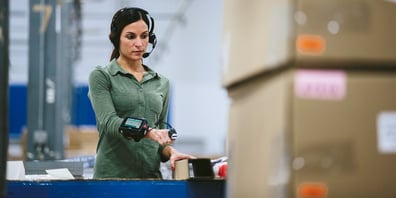 Mobile Devices – While this has a VERY broad meaning, in terms of improving ergonomics, we are referring to terminals like the Zebra device pictured on the right. Wearable technology is designed to accommodate the natural movement of the worker and also leave their hands free to move product, etc. without the repetitive motion of gripping and releasing a full-sized scanner or the time spent picking it up and holstering it in-between scans while moving. It essentially allows the worker to use their own arms more naturally and incorporate the scanning (or other operation) into their regular motion path.
Mobile Devices – While this has a VERY broad meaning, in terms of improving ergonomics, we are referring to terminals like the Zebra device pictured on the right. Wearable technology is designed to accommodate the natural movement of the worker and also leave their hands free to move product, etc. without the repetitive motion of gripping and releasing a full-sized scanner or the time spent picking it up and holstering it in-between scans while moving. It essentially allows the worker to use their own arms more naturally and incorporate the scanning (or other operation) into their regular motion path.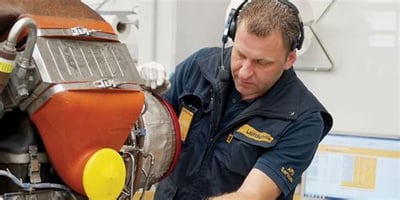 Voice Collection – Similarly to mobile wearable devices, voice collection has made rapid gains in productivity in recent years. By doing everything via voice command and response, workers go out on the floor with only a set of headphones and NOTHING in their hands, making it perhaps the most ergonomic solution available short of replacing people with robots. Voice Collection has been successfully deployed in almost any process area of the warehouse, and in a very interesting innovation, is now used by Lufthansa’s mechanical inspectors to speed the inspection of engines and their maintenance and any needed repair.
Voice Collection – Similarly to mobile wearable devices, voice collection has made rapid gains in productivity in recent years. By doing everything via voice command and response, workers go out on the floor with only a set of headphones and NOTHING in their hands, making it perhaps the most ergonomic solution available short of replacing people with robots. Voice Collection has been successfully deployed in almost any process area of the warehouse, and in a very interesting innovation, is now used by Lufthansa’s mechanical inspectors to speed the inspection of engines and their maintenance and any needed repair.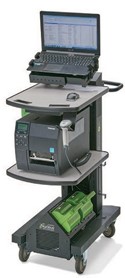 Mobile Workstations – Well, of course no article on the ergonomic aspects of worker comfort and safety would be complete without a mention of the mobile workstation. For those unfamiliar with them, these carts allow workers to take their entire workstation – including laptop, printer, monitor, scanners, etc. and any device they need on the floor (i.e. quality control machines, scales, meters, etc.) and move around the floor effortlessly on a rugged cart that carries heavy-duty batteries. The main benefit where these are deployed is the reduction in footsteps that occurs because workers are otherwise forced to repeatedly walk long distances to get labels from a printer (common in Receiving) or need to take product off the production floor and physically move it to an inspection area. In the latter case, one manufacturer deployed three carts to cover 21 different production areas so that the lone inspector can easily move around with the testing equipment they needed and not only reduce their own fatigue but reduce downtime on the production lines when problems were found.
Mobile Workstations – Well, of course no article on the ergonomic aspects of worker comfort and safety would be complete without a mention of the mobile workstation. For those unfamiliar with them, these carts allow workers to take their entire workstation – including laptop, printer, monitor, scanners, etc. and any device they need on the floor (i.e. quality control machines, scales, meters, etc.) and move around the floor effortlessly on a rugged cart that carries heavy-duty batteries. The main benefit where these are deployed is the reduction in footsteps that occurs because workers are otherwise forced to repeatedly walk long distances to get labels from a printer (common in Receiving) or need to take product off the production floor and physically move it to an inspection area. In the latter case, one manufacturer deployed three carts to cover 21 different production areas so that the lone inspector can easily move around with the testing equipment they needed and not only reduce their own fatigue but reduce downtime on the production lines when problems were found.
Start Somewhere, The Little Things Count Too
As noted earlier, improving retention, while often an issue with compensation, can be addressed by other means as well. The most important thing about developing a plan to reduce churn that includes non-monetary solutions is to be authentic about it. It doesn’t always require you to redesign your entire facility in one swoop. Rather, start by discussing your intentions and involve your teams in the process. Set boundaries of course, but make sure you are creating space to be a listener because that in itself is a morale booster but will also point you to where to prioritize with your limited budget. Think a big fan is cool? Well, everyone says they heat is only bad for 2 weeks a year but the excessive walking they all talk about means a cart is a priority. Your facility’s location, purpose, staffing, etc. will all be a unique combination that you will need to listen to in order to make it as effective as possible. However, you start, the ROI of retaining your employees is worth the effort.











